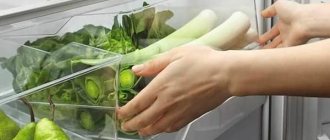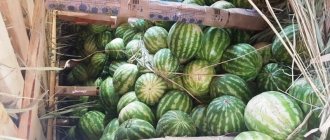Have you bought your favorite flowers in advance and now don’t know what to do with them? We will tell you how to preserve rose seedlings until spring planting.
If you purchased roses in autumn, winter or early spring, then you should try to save the seedlings until the weather warms up. Your main task is to make sure that the buds on them do not wake up ahead of time. For this, seedlings need cold and darkness. Such conditions can be achieved in several ways. Choose the one that suits you best.
Storing rose seedlings in the refrigerator
Perhaps this is the most convenient and common way, because every home has a refrigerator. Seedlings with an open root system are wrapped in damp sphagnum moss or a wet paper towel, placed in a plastic bag, tied and the roses are stored in the vegetable compartment at a temperature of 0 to 3 ° C.
Seedlings with a closed root system (in containers) are also placed in the refrigerator - along with the container. They are simply wrapped in polyethylene to maintain the desired level of humidity.
If you are storing different roses, attach a sticker with the name of the variety to each seedling.
Preparing roses for winter
There are two options for propagating roses - using cuttings and grafting. Propagating a flower by cuttings is considered a more convenient and affordable way. A cutting is a part of a plant that is intentionally separated for propagation.
When growing a rose garden, it is necessary to properly treat the bush in the fall and carry out cuttings of roses for the winter. Before pruning, the bushes are treated with ferrous sulfate. It looks like a free-flowing lump-shaped powder of green color with blue and gray tints, dissolves in water, known as iron sulfate.
- Dilute the vitriol solution - 300 g per 10 liters of water.
- Select the required number of mature, well-preserved shoots with a diameter of about 5 mm.
- Trim leaves.
- Use a knife to mark points in the middle of the shoot and 3 mm below the last bud.
- Make cuts in the marked places. In order not to confuse the bottom and top of the cutting when planting, you can make the first one at an angle of 45 degrees, and the top one straight.
- Apply wax to the mother branch at the cut site.
- Spray the rose bush with the prepared solution according to the instructions.
- The thorns should not be removed, otherwise a growth will appear that will ruin the cutting.
- Treat straight cuts of seedlings with a root formation stimulator (Energen, Novosil, Pollen).
- Wait two hours and rinse with water.
Storing rose seedlings on the balcony in boxes
If there is not enough space in your refrigerator, roses can be “settled” on a glazed balcony until spring. To do this, take a cardboard box, pour a light substrate (for example, peat or sawdust) onto the bottom, place seedlings on it, spray it with cool water from a spray bottle and sprinkle it with the same soil. In such conditions, seedlings safely withstand air temperature fluctuations from –5 to 5°C.
In early spring, when the sun begins to warm up, boxes of roses are transported to a summer cottage and placed in a hole, which is dug in the fall. The boxes are sprinkled with the same soil in which the seedlings are located. After the ground thaws, the roses are dug up and planted in a permanent place.
- Planting roses in open ground in spring - detailed instructions with photos
We tell you how to plant roses in the ground in the spring so that the seedlings take root well and delight you with lush flowering.
- How to plant ground cover roses in spring (step by step instructions with photos)
Follow our advice - and you will succeed!
Possible problems and ways to solve them
Problems with storing cuttings in winter may arise due to improper preparation or care for them. For example, cuttings may freeze. To prevent this, it is necessary to comply with all conditions for sheltering them from frost.
In addition, the shoots can suffer and rot from lack of air and excess moisture . To prevent this from happening, it is necessary to ventilate the cuttings and avoid excessive watering. You need to constantly check the cuttings for mold or blackening. If necessary, you can treat the cuttings or fertilize them with minerals.
If you find an error, please select a piece of text and press Ctrl+Enter.
Since roses are one of the most popular types of flowers, many people want to have a bush of such a plant in their garden or even on their windowsill. There are many ways to propagate roses, one of the easiest and most popular is propagating flowers by cuttings. However, quite often cuttings, for example, from a bouquet given in winter, must be preserved until spring. Let's look at how to do this correctly.
Storing rose seedlings in a basement or cellar
Roses are stored well for 2 months in a basement or cellar with an air temperature of 0 to 3°C. To do this, the seedlings are placed vertically in a bucket or any container and sprinkled with damp river sand, peat or sawdust so that the root collar is slightly buried.
The disadvantage of this method of storing seedlings is that vegetables and seedlings of various plants, which can be a source of disease, are often kept in the basement. Therefore, if possible, roses should be stored separately or as far as possible from other crops.
Storage methods
Experienced flower growers use the following storage methods for bunching petioles during the winter.
In the snow
This method involves digging a hole in a plot of land. Its depth should be 15-20 cm. The bottom of the recess is covered with cotton cloth. Cuttings on which all the leaves have previously been cut off are laid out on top of the litter. The branches are covered with another layer of fabric, after which the hole is filled with soil.
Reference! The edges of the hole should be marked with marks in the form of pegs. This will make it possible to navigate where the bookmark is located.
In the first half of March, I dig up the workpiece and inspect it for callus. This is the overgrown tissue from which roots grow. The petioles are sent to the prepared hole for further development of the plant.
On the balcony
It doesn’t matter if the farm doesn’t have a basement, but traveling to the dacha in winter is annoying. A favorable environment can be created on the balcony. To do this, you will need a wooden box, a little expanded clay and a suitable soil mixture (you can take one ready for flowers).
The container is placed in the hottest zone, filled with expanded clay (layer about 8-10 cm) and substrate (20-35 cm). Experienced gardeners advise doing moisturizing with a spray bottle.
The petioles are laid in the following order:
- First, each workpiece is dipped in water;
- after that there is treatment with a product that activates the growth of roots (the cuttings also need to be dipped in liquid with a diluted drug);
- landing in the ground;
- The box is wrapped in plastic film, and then with a warm blanket.
Periodically, the planting is ventilated and moderately moistened with settled liquid.
In the basement
This is an ideal storage for planting material. There is no need to create special conditions. The air temperature in the underground room varies from 2 to 5 degrees, humidity is also normal (about 60%). The cuttings are kept in a large container or bucket filled with sand or soil. When using regular soil, it is necessary to lighten it with perlite or peat.
Storing rose seedlings in the snow
If you do not have a glazed balcony or loggia, roses can be successfully stored on the site in winter, under the snow. The seedlings are placed in a cardboard box and covered with peat. Then choose the most shaded corner, where the snow usually does not melt for a long time, but in the spring moisture does not stagnate. They put a box with seedlings there, cover it with non-woven material (spunbond, lutrasil, agrospan, etc.) and cover it with snow to make a large snowdrift.
To delay the melting of snow, spruce or pine branches are placed on top of the snowdrift. Under such shelter, the temperature in the box will be maintained at about 0°C, even if severe frost hits. Roses are planted in the ground when the snowdrift has completely melted. If by that time it is still cool, the plantings must be covered with non-woven material.
How to save rose cuttings in winter until planting in spring
Before storing without rooting, trimmed cuttings must be properly prepared:
- select the middle part of the stem with several buds;
- cuttings 15-20 cm long are cut from the shoot;
- the lower cut is made oblique so as not to confuse the top and bottom before sowing;
- the sections are filled with liquid paraffin and covered with garden pitch.
In what conditions do you store rose cuttings?
In the soilIn the cellar
There are 2 ways to preserve rose cuttings until spring: growing a seedling and without rooting. In the latter case, the chopped stems are stored at a temperature of 0 ... + 5 °, wrapped in cloth or newspaper. And to germinate roots, cuttings are planted in nutrient soil on a windowsill or directly in a flower bed.
Right:
- the cuttings were stored, wrapped in cloth;
- the awakened shoots were planted in the ground;
- care regularly: ventilate, revise, moisturize;
- the temperature in the storage is about 0°.
Wrong:
- stored indoors;
- cuttings deteriorate from frequent watering;
- did not cover the roses in the area with the onset of cold weather;
- feed seedlings without roots.
In a refrigerator
When storing gladioli and dormant rose shoots in the refrigerator, they are wrapped in damp paper, no more than 15 pieces.
in one package. Place in a plastic bag with holes and place it on the bottom shelf in the freshness zone. Once every 1-2 weeks, take out the package and open it for ventilation for 5 minutes. Remove rotten specimens. When the wrapper dries, lightly spray it with water.
On the balcony
The condition of the shoots determines at what temperature the cuttings of roses should be stored on the balcony.
If these are just segments of the stem, they are wrapped in paper or agrofibre, placed in boxes and stored at -5...+5°, like cannas. But if these are young seedlings, low temperatures are detrimental to them. Cuttings planted in boxes or pots are stored only in heated loggias with lighting at a temperature of +15...+20°.
In the cellar
To store rose cuttings without roots until spring planting, seedlings from a store with a developed root system are used in a basement or cellar. As with grape stems, dahlias, and roses, cold rooms with a temperature of -1°...+3° and a humidity of 80-90% are suitable.
Cuttings and dormant seedlings are wrapped in a damp cloth and placed in boxes. If the basement is dry, the rose bundles are additionally moistened once a month with a spray bottle.
When stored in the basement, the survival rate of planting material until spring is 60-80%.
In the soil
Flower shoots obtained as a result of autumn pruning can be preserved by burying them in the soil or planting them under the mother bush.
Step-by-step instruction:
- the rose with sealed sections is wrapped in cloth;
- placed in a flat cardboard box;
- dig a trench 60-80 cm deep;
- packaging is placed on the bottom;
- covered with scraps of boards and polystyrene foam;
- fill the hole with earth, marking its boundaries with pegs.
Preparing rose cuttings and storing them in the refrigerator
The second way is to plant directly in the ground. It is best to place the cuttings under a rose bush. This way, heat is retained better, air circulates, and you don’t have to make a separate shelter for them.
The cuttings are buried in the soil half their length and covered with glass jars and plastic bottles. A thick layer of fallen leaves is poured on top, and coniferous spruce branches are applied. The entire structure is covered with double spunbond or film.
In the moss
Using sphagnum moss when storing roses or calla tubers has a number of advantages:
- moss has antiseptic properties - roses do not rot;
- the material perfectly absorbs moisture and also releases it;
- does not interfere with free air circulation.
Each cutting is wrapped in sphagnum moss and placed in a plastic bag with several holes. The packaging is stored in a refrigerator, cellar or on a cold balcony at a temperature not exceeding +5°.
Moss creates good conditions for the growth of callus and the appearance of roots. When a rose germinates, it must be planted in a pot with soil.
In potatoes
When using potatoes, it is important to understand that this is not a storage method. Potato tubers are used for planting cuttings in open ground, but with some caution. If you follow the advice of some gardeners and stick a cutting into a tuber, and then bury them in a flower pot, you will get the following:
- removing eyes from potatoes does not always help - they will begin to grow;
- in moist soil the tuber will begin to decompose;
- many putrefactive and pathogenic organisms are formed;
- the young roots will die, and the cuttings, even with overgrown leaves, will have to be thrown away.
It is important to understand that the abundance of carbohydrates, starch, etc. When germinating roses it is not necessary. On the contrary, the poorer the soil, the longer the roots will grow in an attempt to find additional nutrition.
In the snow
It is impossible to organize a snow shelter during autumn pruning. There is simply no snow at this time. If the cuttings are stored, for example, in the basement, there is no point in moving them when a stable snow cover is formed. But this method is good for preserving purchased canna seedlings, tulip and lily bulbs, and begonia tubers in winter. Roses with dormant buds and tightly tied roots are placed under the snow.
To hide in the snow, do this:
- dig a hole right down to the soil;
- boards are laid on the bottom;
- seedlings are wrapped in spunbond and placed inside;
- lay on top with boards and foam;
- cover with roofing felt;
- pour a high snow slide.
The place is chosen on the shady side and on a hill so that the snow does not melt for as long as possible and there is no water standing under the roses.
Storing blooming roses at home
If you bought not “dormant” seedlings, but a blooming rose in a container, then such a plant can be safely kept at home as an indoor flower, but no more than 3 weeks . During this time, roses usually have time to bloom, having partially used up internal resources, and therefore take on a mediocre appearance, but after planting in open ground they quickly recover and develop normally.
Planting dates for specific regions are set depending on climatic conditions. But in any case, this method of storing roses is only good when buying seedlings in the spring.
How to choose and trim cuttings for storage
The plant from which shoots are planned to be cut should not have any damage or signs of disease. For blanks, twigs with a diameter of a pencil are suitable. Cuttings of this diameter have a better chance of survival and lush flowering.
The propagation method by cuttings is suitable for the following varieties:
- semi-climbing roses;
- climbing varieties of the Rambler group;
- all types of polyanthus, miniature roses;
- Flamentanz;
- Excelsa;
- Rosalinda (Floribunda group);
- Iceberg.
Before pruning, you need to select suitable bushes. You can tell when a plant is ready by how the needles break off. A rose whose thorns break easily is suitable for taking cuttings.
Reference! The shoots should be cut with a tool with a sharp blade. It is pre-disinfected in boiling water or using antiseptic solutions.
Basic rules for preparing cuttings:
- shoots with a diameter of 0.4-08 cm are selected;
- the length of the stem between cuts is 12-15 cm;
- a prerequisite is the presence of 2-3 buds or leaves;
- the cut in the upper part of the stem must be made smooth, the lower one - at a slope of 45°;
- leaves and thorns on the cut shoot should be torn off;
- to stimulate the rooting process, the lower cut is dipped into a solution prepared from Heteroauxin or Kornevin (can be replaced with sweet water: 200 ml of water and ½ tsp of liquid honey).
When choosing a rose bush for the purpose of preparing material for propagation, they are guided by the following criteria:
- the color of the shoots should be dark green or light brown;
- a light core is visible on the cut;
- pliability of the skin to separation;
- a lignified layer can be felt under the bark.
Timing of pruning
Cuttings of roses should be planned for the summer. Suitable months for work: June, July. After autumn pruning, it is a pity to dispose of healthy shoots. They produce strong cuttings when properly stored in winter. Advantages of autumn harvesting: high plant resistance to low temperatures, predisposition to the formation of side shoots.
In the spring you can also do cuttings. Already next season the first buds will appear on the young bush. But roses obtained from spring cuttings will be vulnerable to winter frosts. It is preferable to prune roses to obtain planting material in the fall.
How to store seedlings in a bathhouse
If you are the owner of a real bathhouse with a sealed steam room, you can also store roses in it until planting. The seedlings are placed in a box, placed on the floor in the steam room, covered with a cloth, and the windows are curtained so that the sun's rays do not penetrate and heat the room.
In the steam room, if you do not use it and do not go into it, a low positive temperature remains for quite a long time, even if the sun warms up outside. Frost does not penetrate there either.
In addition to roses, dahlias and other tubers and bulbs can be stored in the bathhouse. Usually they are brought in in the spring; they are not left in the bathhouse for winter storage.
Obtaining planting material
- /ogorod.mirtesen.ru/img/liMarker.png» target=»_blank»>https://ogorod.mirtesen.ru/img/liMarker.png) 0px 3px no-repeat;»> for cuttings take well-ripened, undamaged shoots with a diameter of 4 - 5 mm (about the size of a pencil);
- /ogorod.mirtesen.ru/img/liMarker.png" target="_blank">https://ogorod.mirtesen.ru/img/liMarker.png) 0px 3px no-repeat;"> rose stems are cut into pieces with 3 – 5 buds, it is better not to take the upper part of the shoot, because it may not be ripe;
- /ogorod.mirtesen.ru/img/liMarker.png" target="_blank">https://ogorod.mirtesen.ru/img/liMarker.png) 0px 3px no-repeat;"> in order to properly plant the cuttings in the spring (not upside down) make the bottom cut straight and the top cut oblique;
- /ogorod.mirtesen.ru/img/liMarker.png" target="_blank">https://ogorod.mirtesen.ru/img/liMarker.png) 0px 3px no-repeat;"> make sections 3 centimeters above the kidneys so that in the spring it is possible to update the shoot cut;
- /ogorod.mirtesen.ru/img/liMarker.png" target="_blank">https://ogorod.mirtesen.ru/img/liMarker.png) 0px 3px no-repeat;"> remove all leaves from the shoot.
We tear off all the leaves on the cuttings.
You can take cuttings of roses in the summer (June - July). In the fall, you don’t want to throw away the powerful shoots remaining after pruning, because they are full of nutrients, well-ripened, and therefore you want to save them until spring and start rooting in the spring. The main question: where and how to store rose cuttings in winter. Their further survival will depend on this.
What varieties of roses are propagated by cuttings?
It is not possible to prepare cuttings from every bush: a number of varieties have low survival rate. But most roses that grow in central Russia are easily propagated vegetatively. These include:
- miniature varieties (potted, balcony);
- polyanthus plants;
- semi-climbing roses;
- standard varieties Iceberg, Rosalind, Excelsa and derivatives from them.
Flower growers have a special attitude towards varieties of the hybrid tea group: they have good survival rate, and the bushes tolerate wintering well in the regions of Russia. But their root system is poorly developed. This creates difficulties when cutting roses and growing self-rooted seedlings, increasing the risk of freezing in winters with little snow. Therefore, tea roses are preferably propagated by grafting onto rootstocks with strong roots.
Rooting for storage
You can germinate the preparations using sphagnum or potatoes.
Using moss
To begin, select suitable moss. Sphagnum moss is suitable for germinating rose petioles. It must be treated with Fitosporin before use. The lower cut of the shoots is dipped in a solution that stimulates the rapid germination of roots.
After preparing the planting material, the blanks are wrapped in moss and placed in this form in a plastic bag. After the layer of sphagnum, you can make a layer of newspaper, then put the roll in polyethylene.
In this form, the material is stored in a cool place until spring. In the first days of March, you can begin to root the workpieces. The workflow includes the following steps:
- unpacking cuttings;
- trimming thorns;
- filling the box with moss and river sand (layer of at least 3 cm);
- moistening with settled liquid (from a spray bottle);
- planting cuttings;
- creating a greenhouse effect by attaching plastic film to the sides of the box.
A warm environment without access to sunlight is suitable for root germination. Humidification and ventilation are carried out periodically. After 1-1.5 months, the cuttings can be transferred to the garden bed.
In a potato tuber
The root vegetable is rich in starch and other valuable microelements. Therefore, potatoes are able to create a favorable environment for root germination. To complete the work, you will need to select healthy medium-sized vegetables, cut out the eyes, and treat them with a fungicide for disinfection.
The shoots are first cleared of leaves, the cut from below is moistened in a weak solution of potassium permanganate. Small holes are made in the potatoes of a size that corresponds to the thickness of the workpiece. All that remains is to stick them into the root vegetables and place them in the container. A solution of potassium permanganate is used as an irrigation liquid. Each petiole is closed with a glass jar.
Periodically, the planting must be removed from the polyethylene to allow oxygen to enter. Also, taking into account the degree of moisture evaporation, moderate watering is carried out. For irrigation, it is recommended to use sweetened water (take 1 tablespoon of sugar per 250 ml of liquid).










